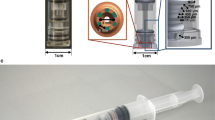Abstract
Rapid Reconstitution Packages (RRPs) are portable platforms that integrate microfluidics for rapid reconstitution of lyophilized drugs. Rapid reconstitution of lyophilized drugs using standard vials and syringes is an error-prone process. RRPs were designed using computational fluid dynamics (CFD) techniques to optimize fluidic structures for rapid mixing and integrating physical properties of targeted drugs and diluents. Devices were manufactured using stereo lithography 3D printing for micrometer structural precision and rapid prototyping. Tissue plasminogen activator (tPA) was selected as the initial model drug to test the RRPs as it is unstable in solution. tPA is a thrombolytic drug, stored in lyophilized form, required in emergency settings for which rapid reconstitution is of critical importance. RRP performance and drug stability were evaluated by high-performance liquid chromatography (HPLC) to characterize release kinetics. In addition, enzyme-linked immunosorbent assays (ELISAs) were performed to test for drug activity after the RRPs were exposed to various controlled temperature conditions. Experimental results showed that RRPs provided effective reconstitution of tPA that strongly correlated with CFD results. Simulation and experimental results show that release kinetics can be adjusted by tuning the device structural dimensions and diluent drug physical parameters. The design of RRPs can be tailored for a number of applications by taking into account physical parameters of the active pharmaceutical ingredients (APIs), excipients, and diluents. RRPs are portable platforms that can be utilized for reconstitution of emergency drugs in time-critical therapies.















Similar content being viewed by others
References
Parshuram CS, To T, Seto W, Trope A, Koren G, Laupacis A. Systematic evaluation of errors occurring during the preparation of intravenous medication. CMAJ. 2008;178(1):42–8.
McDowell SE, Mt.-Isa S, Ashby D, Ferner RE. Where errors occur in the preparation and administration of intravenous medicines: a systematic review and Bayesian analysis. Qual Saf Health Care. 2010;19:341–5.
Aronson JK. Medication errors: what they are, how they happen, and how to avoid them. Q J Med. 2009;102:513–21.
Wheeler DW, Degnan BA, Sehmi JS, Burnstein RW, Menon DK, Gupta AK. Variability in the concentrations of intravenous drug infusions prepared in a critical care unit. Intensive Care Med. 2008;34(8):1441–7.
Abeysekera A, Bergman IJ, Kluger MT, Short TG. Drug error in anaesthetic practice: a review of 896 reports from the Australian Incident Monitoring Study database. Anaesthesia. 2005;60(3):220–7.
Pfizer, I. Genotropin: somatropin [rDNA origin] for injection (package insert), Revised August 2006: New York, NY.
Grassby PF, Hutchings L. Factors affecting the physical and chemical stability of morphine solutions stored in syringes. Int J Pharm Pract. 1993;2(1):39–43.
Hacke W, Kaste M, Fieschi C, von Kummer R, Davalos A, Meier D, et al. Randomised double-blind placebo-controlled trial of thrombolytic therapy with intravenous alteplase in acute ischaemic stroke (ECASS II). Second European-Australasian Acute Stroke Study Investigators. Lancet. 1998;352(9136):1245–51.
The GUSTO Investigators. An international randomized trial comparing four thrombolytic strategies for acute myocardial infarction. N Engl J Med. 1993;329(10):673–82.
Genentech, I. Alteplase (package insert), 2005: South San Francisco, CA.
t-PA Dosing Chart (estimagedd weight). Storke and Cerebrovascular Center. Boston Medical Center. 2014 http://www.bmc.org/stroke-cerebrovascular/services/acute-stroke-protocol-tPA-dosing-chart.htm
Garcia E, Kirkham JR, Hatch AV, Hawkins KR, Yager P. Controlled microfluidic reconstitution of functional protein from an anhydrous storage depot. Lab Chip. 2004;4(1):78–82.
Bendek A, L.J. Automatic reconstitution injector device, U.S.P.a.T. Office, Editor 2012.
May-Newman K, Matyska MT, Lee MN. Design and preliminary testing of a novel dual-chambered syringe. J Med Devices. 2011;5(2):037001–1.
Kremer DM, Hancock B. Process simulation in the pharmaceutical industry: a review of some basic physical models. J Pharm Sci. 2006;95(3):517–29.
Cortes-Quiroza CA, Azarbadegan A, Zangeneha M, Goto A. Analysis and multi-criteria design optimization of geometric characteristics of grooved micromixer. Chem Eng J. 2010;160(3):852–64.
Broboana D, Mihai Balan C, Wohland T, Balan C. Investigations of the unsteady diffusion process in microchannels. Chem Eng Sci. 2011;66:1962–72.
CW H. Volume-fraction techniques: powerful tools for flow modeling. in computational wind engineering conference. 1992. University of Tokyo: Flow Science.
Isfahani AHG, B.J. On the implementation of two-equation turbulence models in FLOW-3D®, 2009, Flow Sciences, Inc.
Yakhot V, Orszag SA. Renormalization group analysis of turbulence. I. Basic theory. J Sci Comput. 1986;1(1):3–51.
Nagano Y, Itazu Y. Renormalization group theory for turbulence: assessment of the Yakhot-Orszag-Smith theory. Fluid Dynam Res. 1997;20(1–6):152–72.
Theodore L. Nanotechnology: basic calculations for engineers and scientists. New York: John Wiley & Sons, Inc; 2006.
Xuan Y, Roetzel W. Conceptions for heat transfer correlation of nanofluids. Int J Mass Tran. 2000;43:3701–7.
Elman N, Patta Y, Scott A, Masi B, Ho Duc H, Cima M. “The Next Generation of Drug-Delivery Microdevices” Clinical Pharmacology and Theraputics, 1009. Clin Pharmacol Ther. 2009;85(5):544–7.
Acknowledgments
This research work was supported by the US Army Research Office via the Institute for Soldier Nanotechnologies (ISN) at MIT (contract: W911NF-07-D-0004).
Conflict of interest
Albert Chi, Sebastian Curi, Kevin Clayton, David Luciano, Kameron Klauber, Alfredo Alexander-Katz, Sebastian D’hers, and Noel M. Elman declare that they have no conflict of interest related to this manuscript.
Author information
Authors and Affiliations
Corresponding author
Rights and permissions
About this article
Cite this article
Chi, A., Curi, S., Clayton, K. et al. Rapid Reconstitution Packages (RRPs) implemented by integration of computational fluid dynamics (CFD) and 3D printed microfluidics. Drug Deliv. and Transl. Res. 4, 320–333 (2014). https://doi.org/10.1007/s13346-014-0198-7
Published:
Issue Date:
DOI: https://doi.org/10.1007/s13346-014-0198-7




